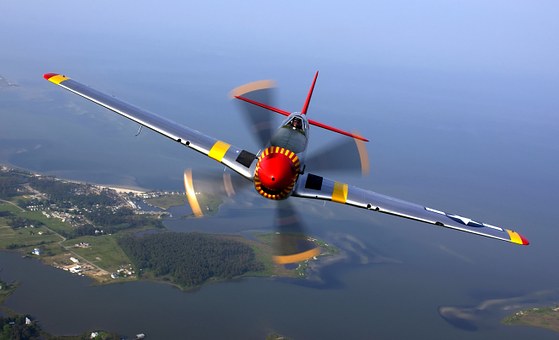However, the effect of one control surface is not always limited to just pitch, roll, or yaw alone. When the deflection of one control surface affects more than one of these orientations, we say that the orientations are coupled. The most important of these coupled interactions is adverse yaw. To better understand the concept, let's study a picture of what happens when the pilot deflects the ailerons to roll the aircraft.
As you can see, the aircraft rolls because one aileron is deflected downward while the other is deflected upward. Lift increases on the wing with the downward-deflected aileron because the deflection effectively increases the camber of that portion of the wing. Conversely, lift decreases on the wing with the upward-deflected aileron since the camber is decreased. The result of this difference in lift is that the wing with more lift rolls upward to create the desired rolling motion.
Effects caused by aileron deflection
Unfortunately, drag is also affected by this aileron deflection. More specifically, two types of drag, called induced drag and profile drag, are increased when ailerons are deployed. Induced drag is a form of drag that is induced by any surface that generates lift. The more lift a surface produces the more induced drag it will cause (for a given wingspan and wing area). Thus, the wing on which the aileron is deflected downward to generate more lift also experiences more induced drag than the other wing. Profile drag includes all other forms of drag generated by the wing, primarily skin friction and pressure drag. This profile drag increases on both wings when the ailerons are deflected, but the increase is equal when the ailerons are deflected by the same amount. However, the induced drag on each side is not equal, and a larger total drag force exists on the wing with the down aileron. This difference in drag creates a yawing motion in the opposite direction of the roll. Since the yaw motion partially counteracts the desired roll motion, we call this effect adverse yaw.
We can correct for this effect in several ways, the most important methods being:
1. Frise ailerons: The concept behind this particular kind of aileron is to minimize the profile drag on the wing with the down aileron while increasing the profile drag on the wing with the up aileron. This difference in profile drag counteracts the effect of induced drag thereby creating a yawing motion that at least partially cancels the adverse yaw effect.
Frise ailerons accomplish this differential profile drag by maintaining a smooth contour between the upper surfaces of the wing and aileron, causing very little drag, while the bottom surface of the aileron juts downward to create a large increase in profile drag. Although this approach is simple and does provide some relief, the performance of Frise ailerons is very dependent on operating conditions. For this reason, such ailerons are often only partially effective at overcoming adverse yaw.


1 2
2. Differential ailerons: Another approach to solving adverse yaw is to deflect the ailerons by differing amounts. The deflection of the down aileron is typically much less than the up aileron so that the additional profile drag is very small compared to that on the up aileron.
As in the case of Frise aileron, this differential profile drag produces a yawing motion that at least partially offsets the adverse yaw, but the effect is limited.
3. Spoilers: Spoilers are long narrow flat plates typically fitted along the upper surface of both wings. In normal flight, spoilers lie flat and generate no effect on the aerodynamic performance of the wing. However, the spoilers can be raised upward into the air flow to generate large turbulence that reduces the lift and increases the drag on a wing.
When used in coordination with ailerons, a spoiler can be used to reduce the lift and increase the profile drag on the wing with the up aileron. As a result, the wing with the down aileron experiences a large increase in lift and a small increase in drag while the wing with the up aileron experiences a large decrease in lift and a large increase in drag. These effects combine to create the desired roll motion and a complimenting yaw motion that is called pro-verse yaw.
4. Cross-coupled controls: One of the most effective solutions to adverse yaw is to couple the ailerons and rudder so that both surfaces deflect simultaneously. As the ailerons create a yaw motion in one direction, the rudder automatically deflects to create a yaw motion in the opposite direction. The two effects counteract each other eliminating the undesired yaw. This form of cross-coupling was often built into the cable-and-pulley control systems of older aircraft. The problem was recognized even as early as the Wright brothers who incorporated such controls into the Wright Flyer. In addition, most major aircraft today utilize some sort of computerized fly-by-wire control system, and it is rather trivial to program cross-coupled control measures into the automated systems.









Comments
Post a Comment